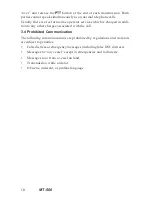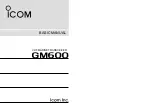
MT-500
9
3.2 Calling Another Vessel
Channel 16 may be used to establish initial contact with another vessel. How-
ever, its most important use is for voice emergency messages. Channel 16
must be monitored at all times except when engaged in actual communica-
tion on another channel. Channel 16 is monitored by international search
and rescue (SAR) authorities, National Coast Guards and by other vessels.
Use of Channel 16 for calling or hailing must be limited to initial contact only.
Calling should not exceed 30 seconds and may be repeated 3 times at 2 minute
intervals.
Prior to making contact with another vessel, determine which channel will be
used for continued communication after the initial contact. Monitor the de-
sired channel for traffic and, when clear, switch to Channel 16 to make initial
contact.
Listen for traffic on the Calling Channel (16). If clear, press the Push To Talk
(
PTT
) button on the microphone. Speak the name of the vessel you are calling
followed by “this is” and the name of your vessel and your call sign. Release
the
PTT
and listen for a reply. When the other vessel returns your call, ac-
knowledge the call with “go to”, the number of the new channel and “over”.
Switch to the new channel and listen for traffic. If necessary, wait for traffic to
clear, and then call the other vessel. As communication proceeds, end each
transmission with “over”. When communication with the other vessel is
completed, end the last transmission with your call sign and the word “out”.
It is not necessary to end each transmission with your call sign, just give your
call sign at the beginning and end of each contact.
Remember to switch to Channel 16 when not actively communicating on
another channel.
3.3 Telephone Calls
You may use your MT-500
transceiver to make telephone calls to persons on
shore. To do so requires the services of marine operators who operate on
designated Public Correspondence channels. There are several channels des-
ignated for this type of traffic and to determine the channel being used in your
area, ask someone with local knowledge, contact a Harbor Master or other
marine authority.
Call the marine operator and identify yourself with your vessel’s name. Nor-
mally you contact a marine operator on their working channel rather than
making initial contact on Channel 16. The marine operator will ask for your
intentions and establish a payment method for the call (collect, credit card,
etc.). When arrangements are complete, your radio communication will be
patched into the telephone line. In conversing with a person on the phone it
is important to use normal radio communication procedures. You should say
Содержание MT-500
Страница 56: ...MT 500 55 9 3 Troubleshooting...
Страница 62: ...MT 500 61 Table 1 of 2...
Страница 63: ...62 MT 500 Table 2 of 2...











































